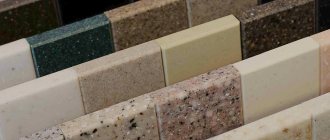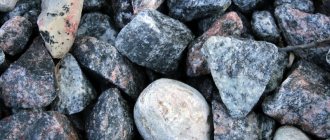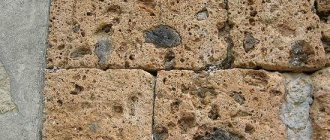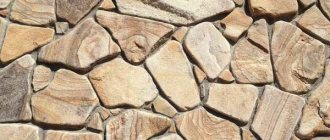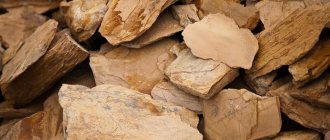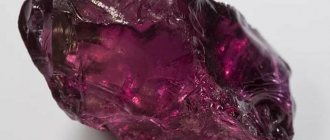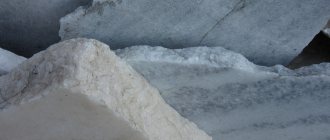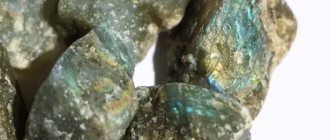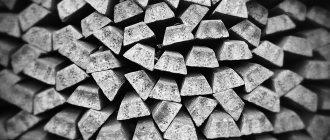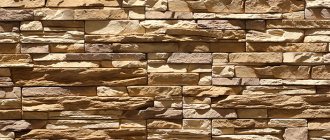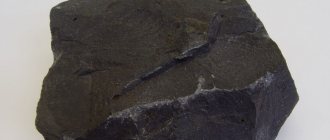The use of granite, due to the advantages of this natural stone over other building materials, is widespread. The mineral not only has a number of properties that determine its practicality, but also captivates with its richness of texture and color. Granite is widely used in construction and cladding. It is used in the manufacture of decorative interior parts and in landscape design. It is also used to make gravestones, monuments and monuments.
Any architectural idea or design solution where granite is used amazes not only with its beauty, but also has a longer service life than any other materials. To decide what can be made from granite and to identify its scope of application, you need to know the characteristics of a particular type of stone, its structure and properties. So, for example, the finer the grains of a rock, the more valuable it is, because its strength depends on this. Fine grain granite has great value in the market. Accordingly, granite stones with a coarse-grained structure are the cheapest option.
What is granite
Translated from Latin - grain. Natural granite is formed in nature over millions of years. There are 2 known types of origin of the stone:
- Volcanic. The frozen lava of a volcano cools down and acquires a rocky structure. Over many years, granite stone crystallizes in it in the form of grains of different sizes. The process of turning sand into granite takes place along the same path.
- Granitization. During the tectonic displacement of continental plates, different rocks moved deeper into the earth. High temperatures and pressures coupled with chemicals caused granitization.
It contains rocks:
- potassium feldspar;
- quartz;
- mica;
- acidic plagioclase;
- amphibole.
Sometimes additional components are found (pyroxene, graphite, talc and others).
In percentage terms, granite consists of minerals:
- 60–65% – feldspars;
- 25–30% – quartz;
- 5–10% – dark flowers.
It turns out that granite is a mixture, not a pure substance.
It has a crystalline granular structure with crystals of large (more than 5 mm), medium (up to 2–5 mm) and small (up to 2 mm) sizes. There may be small empty cavities inside the stone (microlite granite) or cavities filled with other minerals (cellular or drusy granite).
View this post on Instagram
Posted by Travertine, Granite, Glue Almaty (@airo_group) Jun 20, 2022 at 10:00 PDT
Extraction technology
There are several methods for producing granite. The technology is selected depending on the characteristics of the quarry, the type of rock and material capabilities. The purpose of removing a monolithic block to the surface is its safety - after completion of the process, the stone should not have chips, cracks or other damage.
Detonation
The most aggressive method. The idea is to drill holes along the contour of the site, into which explosives are then placed. After detonation, the broken pieces of rock are sorted and sent for further processing and sawing.
The disadvantages of the technology are obvious. As a result of the explosion, many small fragments are separated from the monolith, which are subsequently unsuitable for use anywhere except when processing the stone into gravel. While not so many intact and intact blocks are confiscated. In fact, about 30% of the rock is written off as unprocessable material. In addition, the blast wave significantly affects the structure of granite, which affects its strength.
The only advantage of the method is its low cost. For this reason, the technology is widely used in many fields.
Air cushion chipping
A more loyal way of production. In this case, depressions are also formed along the boundaries of the site into which air is pumped. As a result of high pressure, granite blocks are separated from the main mass.
The technology makes it possible to increase the quality of the extracted stone and reduce the amount of unusable material. However, the method is more expensive and time-consuming.
Application of stone cutters
The most expensive option for extracting material. In this case, equipment equipped with special cutters with diamond nozzles is used.
As a result, the extracted blocks have the correct shape and are free of damage. The structure of the stone is not subject to changes. The field is being developed almost 100%.
Types and colors of stone
The different components that make up the stone, as well as their concentration, determine a wide range of color options. The most famous is gray (light or dark gray shades). Other shades:
- pink;
- lilac;
- orange;
- yellow;
- red;
- blue;
- blue;
- green;
- beige;
- brown;
- white;
- black.
Black gabbro granite has a special texture. When processed, you can get a perfectly smooth shiny surface. Granite stone has various patterns - spots, inclusions, striped-wavy patterns, rings.
Geochemical classification of the White and Chappell granitoids
Types of stone in terms of geochemical aspects:
- S – product of melting of metasedimentary rocks;
- I – the result of melting of metamagma substrates;
- M – formed from magmas containing tholeiitic and basaltic rocks;
- A – consists of incoherent chemical elements.
Classification by grain structure
Based on grain structure, they are distinguished:
- Porphyritic. There are protruding long inserts of quartz, microcline, and orthoclase.
- Pegmatoid. A uniformly grained stone with a symmetrical arrangement of grains.
- Rapakivi. Finnish granite stone. It has red round inserts with a gray frame.
- Gneissic. A classic specimen characterized by a fine-grained texture.
Names of stones based on mineral composition
According to mineral composition:
- Alaskite – dark-colored minerals are absent.
- Leucogranite – there are few dark colors.
- Biotite – the content of this mineral in the stone reaches 6–8%.
- Double-mica granite contains both biotite and muscovite.
- Lithium fluoride – the composition contains lithium mica.
- Alkaline – a large percentage of alkaline compounds.
- Pyroxene – content of orthoclase, quartz, augite.
History and origin of the breed
Data on the existence and use of granite in construction have appeared since the times of the countries of the Ancient World: Rome, Egypt, India. For the first time in 1596, the name was mentioned in science in the work of Caesalpinus “De metallicis”. In his work, the Italian naturalist used the Latin word “granum”, which means grain, as a basis.
Due to its strength, reliability, and durability, geologists have called granite the calling card of the Earth.
View this post on Instagram
Posted by Natalya (@natali_kravchenko_) Apr 7, 2022 at 3:17 PDT
Place of Birth
It occurs in the form of batholiths - huge massifs with a large area. Sometimes it occurs in layers, alternating with other rocks.
Mined on all continents. There are large deposits in Somalia, Ethiopia, Namibia, USA, Italy, Germany, Finland, Great Britain, France (Pink Granite Coast).
In former USSR countries:
- Mokryanskoye field in Zaporozhye region (Ukraine);
- Malokokhnovskoye field in Poltava region (Ukraine);
- Mikashevichi in the Brest region (Belarus);
- Kordai district (Kazakhstan).
In Russia, granite deposits have been found in Karelia (Dymovsky, Kashina Gora granite, Letnerechensky, Ladoga, Serdobolsky), Eastern Siberia, the Urals (Kamenogorsky, Malyginsky, Rezhevsky, Sukhovyazsky, Malyshevsky), the Caucasus, the Far East, Bashkiria (Mansurovsky granite, Tashmurunsky deposit ), Central Russia (Pavlovskoye field).
Many types of stone are named after the deposits where they are mined. For example, red representatives extracted from deposits of the same name: Leznikovsky, Mezhdurechensky, Simonovsky, Emelyanovsky, Tokovsky, Kapustinsky. Gray specimens: Korninsky, Sofievsky, Zhezhelevsky, Pokostovsky.
Not only Russian granite is of good quality, but also Chinese, Indian, Brazilian, Ukrainian (Yantsevsky, Tansky, Vasilyevsky, Korninsky).
To watch a video of how the extraction of useful minerals occurs:
Material properties
The natural mineral has a lot of positive qualities, which explain its widespread use. These include:
- Long service life. Granite can be called an eternal material. It is not susceptible to fungal diseases. The first signs of aging and abrasion of the material appear after no less than five centuries.
- Strength. This natural stone is resistant to compression and friction. Its density is 3 tons per cubic meter.
- Resistance to negative influences of external factors. Granite is not afraid of temperature changes, high humidity, or exposure to ultraviolet radiation.
- Fire resistance. According to this indicator, the material is second only to diamond. Granite can easily withstand temperatures up to +700 degrees Celsius
- Environmental friendliness. It is a completely natural material.
- Frost resistance. The building material is able to survive harsh winters and also thrives in hot countries. This allows it to be used with equal success all over the world.
- Ease of processing. It is easy to grind, polish, and bush hammer, which allows it to be used to make products of any shape and size.
Natural stone goes well with other building materials. It is distinguished by a wealth of textures and colors. This set of qualities allows you to use granite to perform any type of work. Moreover, of all the known natural materials intended for cladding and construction, it is the cheapest, as it belongs to a common rock.
Stone processing
The stone is very durable. You can split granite stone with a hammer, cleaver, or sledgehammer. You can break the stone into two parts, split it into several large parts, knock off some parts (shards) or trim it, giving it the desired shape, creating edges - smooth surfaces (faceted granite).
During processing, diamond drills are used for cutting and grinding. It is easy to give the source the desired shape using a tesque. Sometimes heat treatment is required. Heat-treated granite has a rough surface. Bush hammered granite also has such a surface. The essence of the treatment is the shock-rotational effect of special sprockets made of hard alloys.
On the map, the symbol for granite is crosses (pluses) in a frame.
Also watch the program about processing:
Scope of application
On sale you can find granite blocks, slabs, paving stones, crushed stone, as well as granite chips.
All these types of granite material are used for different purposes:
- Construction projects and monuments are erected from granite blocks
- slabs are used in the external cladding of facades and basements of buildings, as well as covering walls and floors indoors;
- granite paving stones - for paving streets and roads;
- crushed stone and chips are used in finishing works, decoration and landscape design (granite chips for paths), granite screenings are used in the production of concrete to achieve high strength indicators.
Granite finishing can transform any building, both inside and out. Using granite stones in a variety of shades, ranging from deep red to pearl gray, designers have successfully used the mineral for interior design. Properly combining it with wood, metal or ceramics, they create amazing objects - mirrored countertops for the kitchen, summerhouses, flower beds in the style of a Japanese rock garden, monumental polished stairs and other masterpieces.
How to distinguish natural granite from artificial
There are several signs that will help distinguish a real stone from a fake:
- Temperature. The original is cold. It takes a long time to gain temperature if you hold it in your hands. The fakes get warm quickly.
- Resistant to damage. Artificial analogues are easily scratched, unlike a natural sample.
- Drawing. Real stone has unique patterns that are not repeated. Imitation may have repetitions of some elements.
- Shine. The original is always matte, but a fake can be too shiny.
- Price. The suspiciously low price of granite products should alert you.
Advantages and disadvantages of granite tiles
Before purchasing this expensive facing material, it is necessary to obtain and comprehend the available information about its advantages and disadvantages. It is especially important to pay attention to the shortcomings of granite tiles, since even during the operation of lined surfaces they can become those “pitfalls” that will lead to complete disappointment of the owners.
Park paths and areas lined with granite tiles
So, the advantages of granite tiles include the following characteristics:
- Strength of the material . The coating is resistant to dynamic loads, therefore it is used in places with increased intensity of human flow, such as city parks and public gardens.
- Resistance to external influences . Granite tiles properly fixed to the external walls of a house will show enviable resistance to low and high temperatures, humidity and mechanical stress.
- Protective functions . The material is not only resistant to external influences, but also perfectly protects the base on which it is fixed from them.
- Water resistance of granite . Due to this quality, the tiles do not require additional treatment with water-repellent compounds. Therefore, not only additional funds will be saved, but also time.
The area in front of the house, lined with polished granite tiles
- Aesthetics of the material . Granite not only has an aesthetic and respectable appearance, but like any “classic” it has not gone out of fashion for centuries. Such cladding will always remain appropriate.
- Durability of finishing . As time itself proves, the service life of granite cladding can be measured not in decades, but in centuries.
- Variety of colors and shapes . This factor allows you to choose the color of the facing material for any area of interior or exterior decoration, including the design of the area around the house.
- Exclusivity of the drawing . There are materials that are similar to each other, but no two identical tiles can be found in nature!
- Naturalness of the material . The tile is a natural processed material and does not contain artificially created ingredients. Granite, as a rule, has a natural radioactive background - 10÷15 μR/h, which is safe for the environment and humans.
- Easy to care for . Granite coating or cladding does not need to be painted or coated with protective compounds. It is enough to carry out wet cleaning if necessary.
Now we should outline the disadvantages of this facing material:
- Coldness of the tiles . Granite coating is a cold material.
- Heavy weight . This characteristic complicates transportation and installation work. If you have no experience working with this material, you will have to invite at least two qualified craftsmen to install it.
- High price . Despite this factor, granite tiles are still more affordable compared to other natural materials of their mineral group.
Adhesive for installation of granite slabs
Special materials for installation are required . To fix the tiles to the surface, special compounds are used, which will require much more than for laying other similar materials. There are adhesives for different thicknesses of slabs, so when purchasing the composition, you must take this into account. Granite can only be mounted on reliable, solid foundations, without the slightest hint of deflection.
To be fair, it should be noted that the “cons” listed above can be considered not so significant, especially compared to the advantages of the material.
Properties and applications of granite
Most often, stone is used in construction, given its strength, resistance to weather influences and temperatures. It does not absorb moisture, which justifies the use of the material near bodies of water.
Areas of application of natural and artificial materials (porcelain stoneware):
- building cladding;
- design of embankments, central streets, metro stations, underground passages;
- production of countertops, window sills;
- flooring in private properties, museums, theaters;
- design of stairs;
- production of grave monuments;
- addition to road surfacing composition.
The stone is durable, lasting for hundreds of years.
View this post on Instagram
Publication from Bulat (@mozayka_mramor_95_) June 20, 2022 at 10:51 PDT
View this post on Instagram
Publication from the Magazine “House in Details” (@domvdetalyah71) June 22, 2019 at 12:57 PDT
View this post on Instagram
Publication from Diamond Stone (@diamondstone.ru) July 13, 2022 at 5:03 PDT
How does the composition of granite affect its decorative properties?
Decorative properties are affected by impurities in the composition. They give the stone rare shades, for which they are valued on the market.
- Green – Green Ukraine, Maslovsky (Verde Oliva), Butterfly Green.
- Blue – Ultramarine, Sodalite Blue, Azul Macaubas.
- Reds - Imperial Red, Syuskyuansaari, Kapustinsky, Leznikovsky.
- Yellow – Sunset Gold, Crystal Yellow.
- Brown - Dymovsky, Elizovsky.
- Tsvetnoy – Didkovichsky, Yuzhno-Sultaevsky, Beinbook Brown.
- Black – Absolut Black, Black Galaxy, Gabbro-diabase, Bukinsky.
Physicochemical characteristics
Granite is famous for its strength, which is almost 2 times the strength of marble (see comparison of granite and marble). It is resistant to precipitation, acids, frost, and heat. Does not absorb moisture, fireproof.
Maintains external aesthetics for many years, despite external adverse influences. Clay and sand are formed when granite breaks down under the influence of sun, water, wind, and living organisms.
- Density: 3.17 g/cm3.
- Hardness on the Mohs scale: 6–7 points.
- Specific gravity: 2.7 g/cm3.
- Abrasion: 1.4 g/cm3m.
- Compressive density: 300 mPa.
- Compressive strength: 299.6 MPa.
- Bending strength: 57 MPa.
- Radioactivity of granite: weak, contains a small number of isotopes. Requires measurement with a device.
- Electrical conductivity: none.
The chemical formula is long, depending on the composition: SiO2 – 70.18; Al2O3 – 14.47; K2O – 4.11; Na2O – 3.48; CaO – 1.99; FeO – 1.78; Fe2O3 – 1.57; H2O – 0.84; TiO2 – 0.39; MnO – 0.12; MgO – 0.88; P2O5 – 0.19. The percentage of elements is indicated through a dash.
Medicinal properties
In lithotherapy, the stone is used to treat bronchopulmonary diseases and diseases of the cardiovascular system. Helps with problems with joints and bones (especially with diseases of the spine). For colds, it helps to quickly reduce body temperature.
Magic properties
People believe that the stone can protect the house from negative energy. This is facilitated by granite decorative elements in the interior or talismans.
Granite amulets help develop intuition. Improves brain function.
As a talisman and amulet, granite helps people associated with mental work (educators, teachers, students, scientists).
In addition, watch the documentary:
Granite products
Products made from this natural stone can be divided into two main groups: ritual and architectural and construction. The first type includes:
- Standard monuments are rectangular in shape and figured, with a more complex profile.
- Exclusive ritual products that are made according to unique projects - they can combine several types of granite of different colors and textures.
- Ritual decorative items: vases, candlesticks, tables, fences, granite benches, etc.
- Memorial complexes are burial places where, in addition to the main products (monuments, tombstones, slabs), decorative ones are also installed.
Architectural and construction products include:
- Structural and decorative elements for external installation: facing slabs for the facade; paving stones; steps for the porch made of granite; curbs; paving slabs for paths; fountains.
- Decorative elements for indoor use: window sills; granite floors and tables; interior staircase components; sculptures; vases; columns; fireplaces.
Slabs
For the manufacture of granite products, slabs are used - integral seamless slabs. They are sawn from stone blocks taken from the quarry. Various shaped parts and decorative elements are cut out of the slabs, or they are used entirely for cladding floors, facades, and granite walls. They are rectangular in shape, and the dimensions and thickness of the slabs depend on their purpose. The slabs are made from 1.8 to 3 m long and from 0.6 to 2 m wide. The thickness is from 2 to 3 cm.
All blanks have their own unique pattern. Designers can wait months for the most beautiful granite slabs to become available in warehouses for their exclusive projects. Kitchen and bathroom countertops made of granite slabs, bar counters, and columns are widely used in interiors. Mostly polished blanks are used for interior decoration. Building facades (eaves, parapets) are usually made of heat-treated slabs.
Paving stones
Paving roads, sidewalks, paths and other areas with granite stone is not only about creating a super-durable coating. This way you can improve and make the appearance of any area attractive.
The central roads of the metropolis, rolled into asphalt, turn it into an industrial province, while a small town with narrow, cozy streets paved with granite paving stones attracts crowds of tourists.
Granite paving stones are individual stone elements of different shapes and sizes: rectangular, square, rounded or figured. This variety allows you to create different patterns and use paving stones in any style of landscape design.
Granite paving stones
All fragments of paving stones are tightly laid on a sand-cement base or on sand - thus creating a high-quality and durable road surface that can withstand enormous loads.
Types of granite paving stones:
- Chopped - laying material in the form of cubes with uneven edges (standard dimensions 100x100x100 mm). Used for direct paving, gives an antique effect.
- Sawn-split - made by cutting a granite slab into strips with their further splitting into separate bars. The dimensions of standard square paving stones are 100x100x60 mm, rectangular ones - 200x100x60 mm. But there are also other sizes, for example, 100x100x100 mm or 50x50x50 mm. In addition, it is possible to produce bars of conical, trapezoidal and other shapes.
- Full-sawn paving stones are the most beautiful and also the most expensive paving stones with smooth edges, allowing them to be laid with virtually no noticeable seams. After processing it is smooth, but not slippery. It is sawn with a diamond tool and has the following standard dimensions: 200x100x60 mm. It can also be produced in other sizes (100x100x30 mm, 100x200x100 mm, etc.).
Floors
Granite is a material that allows you to create the most durable and unique floor covering. Natural stone will be appropriate in the kitchen, terrace, bathroom, living room. Granite floors are made from 10 to 100 mm thick. The following types of elements are used for installing floors:
· Tiles in the shape of a square or rectangle (maximum dimensions 60x60 cm).
· Slabs measuring up to 2x3 m (the coating is more monolithic and the texture of the stone is better visible).
· Artistic elements of various, sometimes complex shapes, which are used to create ornaments and designs.
Cut tiles or slabs with an angle grinder using a diamond cutting disc for stone.
It is worth noting that granite floors in residential areas must be heated, since granite is a cold stone.
Window sills
Successfully matched to the interior and professionally manufactured, granite window sills can delight with their luxurious, solid appearance for decades. They fit perfectly into both classic and modern design styles and add sophistication to the room. Granite window sills are very practical: they are easy to clean, are not afraid of moisture, mechanical damage, temperature changes and do not stain. According to their purpose, they are divided into the following types:
- Standard - for lining a regular opening under a window.
- Low and wide - it can be used as a place to relax.
- Window sill-tabletop (kitchen cabinets are installed under it).
- Window sill as a continuation of the stone bar counter.
Granite window sills are made in different shapes: standard straight, bay windows, curved or cut according to specially designed designs. The edges of window sills can also be finished in different ways and have straight, rounded, oval, beveled or irregular shapes.
Stairs
Granite stone is virtually indestructible in high traffic conditions. Therefore, in the construction of public buildings, granite is most often used for finishing stairs. Subways, train stations, restaurants, shopping centers, offices and private homes - wherever durability and aesthetic appearance are needed, granite steps are the best solution.
Granite stairs are the best solution in high traffic conditions
Granite stairs can be of two types: solid (from one slab) and overlay (from separate slabs). It consists of treads - horizontally laid slabs and risers - vertical elements.
The following manufacturing options are available:
- Straight - simple and versatile design. With this installation method, granite can be trimmed immediately at the construction site.
- Curvilinear segments - steps are installed in polyhedral blocks.
- Radial - with smooth, smooth rounded corners and a minimum number of joints.
To prevent granite steps from slipping, the material is subjected to special processing: hammering and heat treatment of the entire surface of the tread or individual strips measuring 50 mm. Parallel cuts and an abrasive belt are also used.
In addition to steps, granite balusters are also made - they complete the appearance of the staircase and ensure the convenience and safety of using the staircase.
Tombstones
Making monuments for graves is a type of activity that will always be in demand. Granite is a worthy material for making a tombstone. Such a monument will be strong and durable. Types of granite tombstones: horizontal slabs, steles, sculptures, crosses, architectural structures.
The basis for future monuments is slabs. After cutting out the required shape, the material is ground and polished to give the tombstone a glossy shine. Chemical treatment is also used for a patination effect, which well emphasizes the natural structure of the material. After this procedure, moisture-proof impregnations are applied.
Professionally made monuments can become not just granite tombstones, but a work of art, albeit a ritual one. In each of them you can artistically embody the image of a departed person, his character and destiny.
